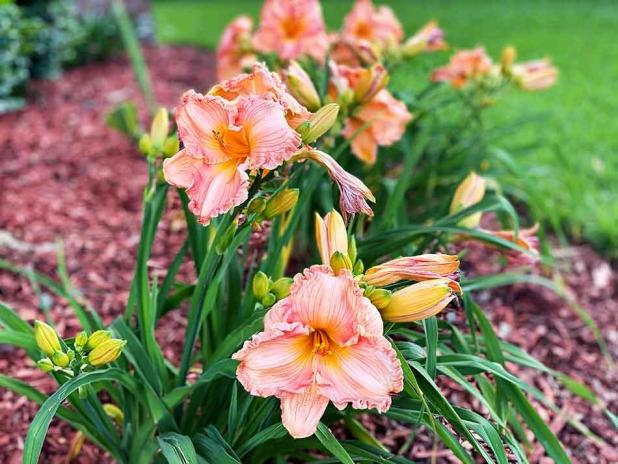
Daylilies can produce several flower heads on one stalk and blooms open one at a time for a single day.
—LSU AgCenter/Heather Kirk-Ballard
Get It Growing: Daylilies varieties are vast
Daylilies are impressive this time of year. Why aren’t they in every landscape? These herbaceous perennials are one of the most carefree flowering plants you can plant in your garden.
The daylily is a member of the lily family (Liliaceae), and its Latin name Hemerocallis translates to “beauty for a day” because the flowers typically open for only one day. Even though blooms only last one day, they are followed in quick succession by bloom after bloom for an extended period through the summer and can go into the fall.
Flowers are trumpet shaped, and there are double and single forms that range in size from 2 to 6 inches. Daylily flowers first came in colors of burgundy, yellow and orange, but through breeding, there are many new colors to choose from such as gorgeous peach, creamy whites, purples, lavender, rose and even pinks. There are multi-colored selections as well.
Flowers form on single stalks that can contain several blooms that grow up to 36 inches, making them an excellent cut flower selection for the garden. The heirloom types make especially great cut flowers.
It is best to cut daylilies with buds that are just about to open. Remember, flowers will only be open for one day. There can be more than one bloom per stalk, and individual blooms will continue to open over a few days.
There are different types of daylilies. Some are evergreen or semi-evergreen in that their foliage will remain green in winter in mild climates, and many varieties go dormant and die back to the ground in winter regardless of the climate.
Many cultivars will rebloom, and most can be encouraged to produce new blooms by removing faded flowers. There also are compact varieties that sport smaller flower heads and are well suited for small areas and for use as a border plant.
The plant foliage is narrow and strap-like with thick blades similar to that of liriope but much softer, less glossy and a lighter shade of green. Once established, daylilies are drought tolerant.
Plants grow best in full sunlight in a fertile, moist and well-drained soil, but will also grow in partially shaded areas. The best time to plant them in the garden is fall and early spring. For containers, just about any time will work.
Daylilies tolerate a wide range of soil types and are easy-care with few disease or major pest problems. Aphids, spider mites and thrips can be a problem and prevent flower blooms from opening if heavily infested. Use a year-round horticulture oil spray to help control.
Overcrowding of plants can cause a decline in flower production. It is best to thin plants every three to five years in late fall or after plants have finished blooming. You can replant in other areas or share them with friends.
Plants are easily propagated by dividing clumps, or they can be grown from seeds. They produce three-celled pods with black seeds. Fertilize plants in late winter or early spring with a low-nitrogen fertilizer such as a 5-10-10 or 6-12-12 at a rate of ½ cup per square yard.
Some varieties recommended by AgCenter professor emeritus Allen Owings are the Joy of Living that is part of the Southern Living Plant Collection, Butterfly Bliss (lavender), Cele-bration (peach with rose coloring), Goldie Locks (ruffled golden yellow), Family Reunion (yellow), High Voltage (bright red). Some others include Catherine Woodberry (lavender- pink), Grape Ripple (purple-burgundy), Happy Returns (bright yellow), Pretty Woman (rosy pink), Ruby Stella (red) and Stella d’Oro (creamy yellow).
Check out local garden centers for their available selections. If you are close with neighbors, ask them to share a few when they thin their plants.
